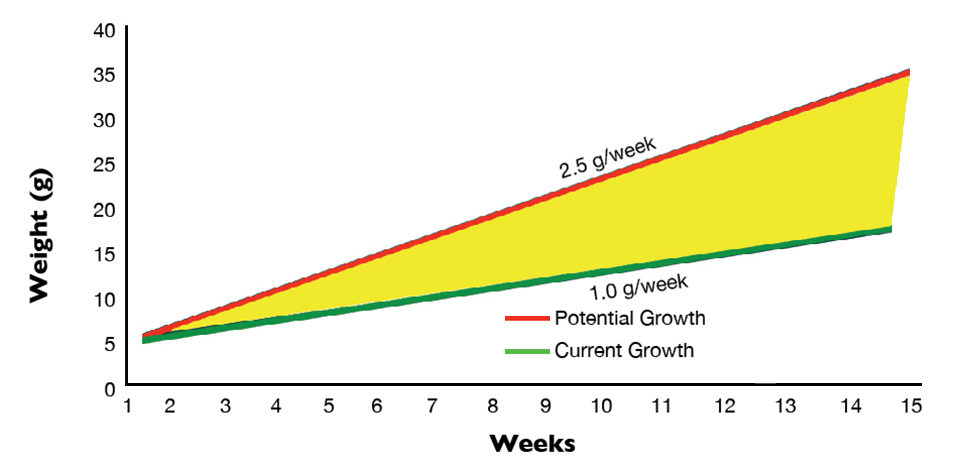Learning, managing limiting factors will improve profits

Under normal production conditions, growth rate is considered the primary factor in affecting pond profitability. In spite of its importance, few people actually know the maximum growth rate potential of their shrimp.
Why is growth rate important?
Faster growth rate contributes in many ways to the profit equation. When shrimp grow faster, they are in the ponds for a shorter period of time, which significantly reduces the risk factor. There may be opportunities to grow the shrimp to a bigger size or increase the number of crops per year.
Less time in the pond can result in higher survival and lower feed-conversion ratios. In addition, total operating costs are reduced. All of these factors contribute to higher profits.
Understanding growth rate
In order to manage growth rate effectively, it is first important to understand how shrimp grow. There are three main phases in shrimp growth. A hypothetical example is presented in Fig. 1.

First, from approximately 1-day-old postlarvae to 3 or 4 grams, the animals grow exponentially and gain weight at an increasing rate. During the second phase, up to approximately 25 grams, the growth rate of shrimp is lineal and fairly constant per unit of time. At about 25 grams or when the animals start reaching sexual maturity, females continue to grow at the same lineal rate, but the growth of males declines. Most of the increase in animal weight takes place during the lineal phase.
Genetic potential for growth
All animals are products of their genetics and their environments. To determine the maximum growth rate of shrimp as determined by their genetics, we must allow them to grow under optimum conditions that are not limiting in any way. Fig. 2 presents the data where a line of fast-growing shrimp was stocked at very low densities and fed a very high-quality feed in a very favorable greenwater environment.

Sample counts were taken approximately every seven days. In a regression analysis, the average weekly growth rate was calculated as 2.59 grams – a very good estimate of the maximum growth rate, as determined by the animals’ genetics.
Seeing opportunity
A visual illustration of the opportunity from faster-growing animals is shown in Fig. 3. If the normal expected growth on a farm is 1.0 grams per week, as represented by the bottom line, and the maximum growth rate from the animal’s genetics is 2.5 grams per week, as shown by the top line representing the potential, then the opportunity is represented by the yellow area.

Within this area, we may safely conclude that one or more environmental factors are limiting. It could be nutrition, feeding technique, any of the many water quality parameters, temperature, disease, etc. If we can learn what these limiting factors are and manage them more effectively, profits will improve.
Rising goals
Fundamental to understanding the maximum amount of additional growth that is achievable is understanding the maximum growth potential determined by the genetics of shrimp. Selective-breeding programs are being rapidly employed by progressive shrimp hatcheries. One of their selection criteria is faster growth, which can be increased up to 10 percent/generation. Goals for maximum growth can therefore constantly increase, and managers will be accordingly required to continually make improvements in their production and management techniques.
Commercial breeders and suppliers of poultry, swine and row crops all provide performance statistics based on genetically selected strains. For broilers and turkeys, statistics are available for growth rate, feed conversion and survivability. These examples could be used as models within the shrimp industry. Shrimp hatcheries should develop these relative types of performance profiles and supply them to the industry for each of their genetic lines.
After years of using wild-caught postlarvae for stocking at farms, the aquaculture industry has moved almost exclusively to hatchery-reared animals. As a result of selective-breeding programs, significant increases have been made in rates of growth. There have been reports of shrimp growing 7-10 grams per week during the lineal growth phase.
Bottom Line: Know the genetic potential for maximum growth rate.
(Editor’s Note: This article was originally published in the September/October 2011 print edition of the Global Aquaculture Advocate.)
Author
-

Thomas R. Zeigler, Ph.D.
Senior Technical Advisor
Past President and Chairman
Zeigler Bros., Inc.
P. O. Box 95
Gardners, Pennsylvania 17324 USA[109,111,99,46,100,101,101,102,114,101,108,103,105,101,122,64,114,101,108,103,105,101,122,46,109,111,116]
Tagged With
Related Posts

Health & Welfare
10 paths to low productivity and profitability with tilapia in sub-Saharan Africa
Tilapia culture in sub-Saharan Africa suffers from low productivity and profitability. A comprehensive management approach is needed to address the root causes.

Aquafeeds
ASAIM addresses challenges to growth of marine fish farming in Southeast Asia
In its efforts to advance sustainable aquaculture practices and the use of soy-based feeds in Southeast Asia, the American Soybean Association International Marketing Program (USAIM) has identified several challenges.

Health & Welfare
Achotines laboratory home to continuing studies of tuna early life history
The Inter-American Tropical Tuna Commission Achotines Laboratory in southern Panama is the world’s only facility with nearly year-round availability of tuna eggs and larvae. A study is comparing the reproductive biology, genetics and early life history of yellowfin and Pacific bluefin tuna.

Intelligence
Adding value to tilapia to tap into U.S. market
New markets for tilapia and expansion of existing ones can be created by planning and implementing properly designed geographic strategies to meet discriminating consumer preferences. Low labor costs in most producing countries promotes value-adding by the production of fresh fillets.

